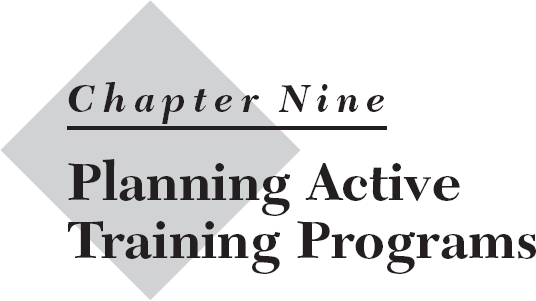
At this point in the design of your active training program, you've established your objectives and sequenced activities to support them. You have now reached the point where you can organize all of your design ideas on a given topic into a complete program. This final step in designing involves the creation of the outer shell of the program, sometimes referred to as the “macrodesign.”
THE MACRODESIGN OF AN ACTIVE TRAINING PROGRAM
The introduction to Part Two proposed that an active training program was characterized by
- A moderate level of content
- A balance between affective, behavioral, and cognitive learning
- A variety of learning approaches
- Opportunities for group participation
- Utilization of participants' expertise
- A recycling of earlier learned concepts and skills
- Real-life problem solving
- Allowance for future planning
With these characteristics in mind, let's review a macrodesign for a total program of a minimum of six hours length. If your time is limited, it may be difficult to employ all aspects of this plan. In this case, adjust the macrodesign that follows to your time constraints.
Opening Activities
Design activities that build interest in the entire course and introduce some of the major ideas of the first part of the program. Also use this time for group building and learning about the participants. An initial case study that invites participants to start thinking ...
Get Active Training: A Handbook of Techniques, Designs, Case Examples, and Tips, 4th Edition now with the O’Reilly learning platform.
O’Reilly members experience books, live events, courses curated by job role, and more from O’Reilly and nearly 200 top publishers.

